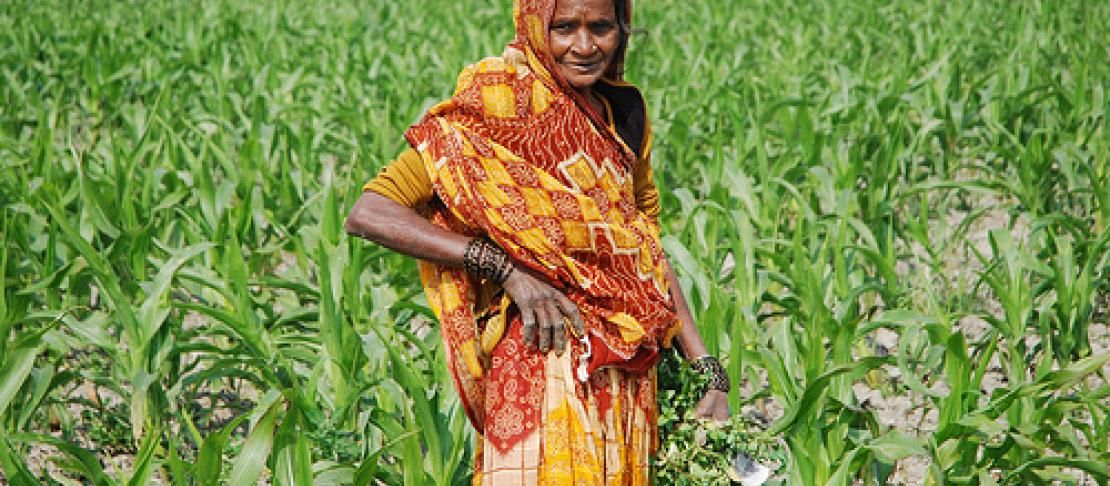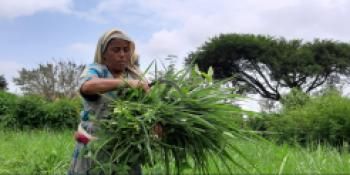Hundreds of Bihar women get trained on climate change and food security

By Aditi Kapoor
I was apprehensive. The training of trainers (ToT) had gone off well, and our partner organisation, the Bihar Mahila Samakhya, was well versed in carrying out training programmes, boasted good training facilities, had demonstrative experience of mobilising rural elected women and enjoyed a certain degree of acceptance by the district administration. The State Panchyati Raj Department had circulated a letter to all District Administration heads to ensure that elected women leaders would be able to attend the training workshops. Yet, I was nervous.
There were many questions in my mind: Would the trainers be able to bring to the fore the complex links between ‘Gender, Climate Change, Agriculture and Food Security,’ the topic for training? Would the trainers remember what they had learnt from the many presentations at the ToT?? Would they be able to use the training manual effectively? Would they be able to link the subject matter of the training to the lives of their trainees? Would the elected women trainers really participate in the roll out of the trainings across 17 districts?
The training, part of the CGIAR Research Program on Climate Change, Agriculture and Food Security (CCAFS) activities and carried out by Alternative Futures in collaboration with Bihar Mahila Samakhya, envisaged bringing together over 1,500 trainees, largely from the local self-governance Panchayati Raj Institutions (PRIs) to understand issues related to gender and food security in the wake of climate change.
In the final evaluation, the training workshops turned out to be in shades of grey. Trainers ranged from being not-so-good to being excellent – with some of them invited to be resource persons in multiple districts. Similarly, one encountered highly motivated elected women representatives who wanted to share the knowledge they had picked up at the ToT with other PRI women leaders.... to those who simply failed to show up at the training workshops in held in their administrative blocks! Yet, there were two things that lit up my heart! One, the most popular sessions were those where concrete adaptation solutions for women were discussed with local government agricultural extension officers who came in as resource persons; and two, several Mahila Samakhya district-level offices decided to include a capsule on climate change and food security as part of their regular training agenda with groups of village women.
An interestingly gender-responsive innovation brought in by some of the trainers was to use pictures, songs and poems as a medium for getting their message across. For example, the diagrams given in the training manual to explain the technicalities of climate change were made into big posters and hung in the training halls so that women could see them anytime and refresh their understanding on what causes climate change and how the sun, the land and the sea behave differently and influence climate change.
Again, one of the most popular trainers, Jashoda Kumari from Muzaffarpur, composed songs and poems in the local language to explain some of the more complicated content in the training course. “Songs always catch women’s imagination as they can then keep singing it and understand difficult content,” she said. “In our folk culture, songs are one of the most popular way of reflecting our joys, our sorrows, our pain and our fears.” Indeed, the second day of almost all training workshops would start with the women singing songs on domestic violence and dancing to them! Externalising the pain and sharing it among themselves through the medium of songs and dance brought this ‘private’ or ‘family affair’ into the public arena and acted as a stress-buster for them. It also re-affirmed the use of traditional or folk media as a meaningful training tool.
Through these training workshops, women leaders in rural Bihar realised for the first time ever that something called ‘climate change’ was the cause of their sufferings in recent times - the increased frequency, intensity and unpredictability of floods; the erratic rainfall patterns; the shortened but intense winters; the intense heat during longer summers; and more water shortages. As a result, women were facing failed crops, lower productivity and higher migration of their menfolk who went off to nearby towns and far-off cities to find wage labour.
“This training has been a revelation!” said Sarita Kumari, the trainer from district Purnea. “I have participated in many kinds of trainings prior to this one but I never knew that something is happening to our climate which is why our agriculture and food security is being affected. Now I can relate climate change to what I see happening on our farms.” So fired was Sarita by the training that she took up discussions on climate change and water conservation with the mukhiya (head of the village panchayat) on her own. Sarita was later invited to train women in Ketihar district as well.
During the training, I was not surprised to find that women were well conversant with the different ways in which their work and men’s work was getting affected by the vagaries of climate change. “We have to walk miles to collect drinking water during floods,” said Asha Devi, a ward member from Asma village (each village is divided into wards) in district Darbhanga. Mina Devi, another ward member added that weeding is a woman’s job and “scarcity of rains (during the rainy season) now makes the soils so hard and rough that weeding has become a very difficult and painful task.” Kaushalya Devi, a ward member from village Goura in district Sitamarhi said women often went to bed hungry because they could not find dry wood and a dry place to cook during floods. Men could travel by boat and access relief packages more easily. The solution, Kaushalya Devi said, lay in making cooking gas available in the villages and weaning people away from firewood. An adaptive strategy that would work well for women!
During discussions, women pointed to more adaptive strategies. Shiv Kumari from village Narphora in Sitamarhi said, “We need to harvest rainwater during floods and this will help us during drought times.” Gandhi Devi from village Rampur Parori, Sitamarhi district, said, “We must prepare ourselves for disasters by storing food grains.” Ghurni Devi at the Sitamarhi training summed it up: “We women are elected so that we can raise our voices for all the women in our villages.”
This is exactly what this training for elected women leaders endeavoured to do.
WATCH: Women's voices in Nepal - Stories of Climate Change
Read more about this project on our blog.
This blog post was prepared by Aditi Kapoor, Director, Alternative Futures, India. Interested in gender? Read more gender-related blog posts here on our blog. To get more updates on our gender research, like us on Facebook, and follow us on Twitter @Cgiarclimate.


